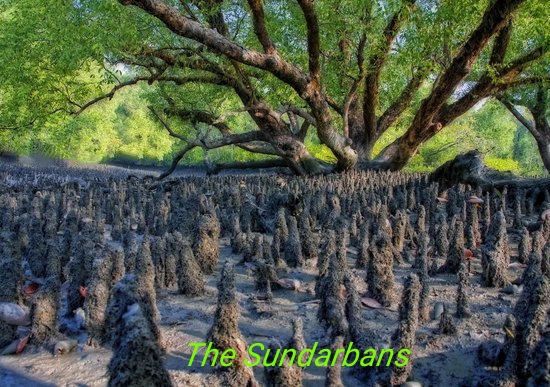The Sundarbans
One of the biggest heritage of the world is the Sundarbans.It is also a proud for the people of that region.Here is a small text about that collected from Banglapedia.Hope people wil know something about the region.

Sundarbans, the largest single block of tidal halophytic mangrove forest in the world, located in the southwestern part of Bangladesh. It lies on the Ganges-Brahmaputra Delta at the point where it merges with the bay of bengal. The forest lies a little south to the Tropic of Cancer between the latitudes 21°30'N and 22°30'N, and longitudes 89°00'E and 89°55'E. With its array of trees and wildlife the forest is a showpiece of natural history. It is also a centre of economic activities, such as extraction of timber, fishing and collection of honey. The forest consists of about 200 islands, separated by about 400 interconnected tidal rivers, creeks and canals.
The Sundarbans was originally measured (about 200 years ago) to be of about 16,700 sq km. Now it has dwindled to about 1/3 of the original size. Because of the partition of India, Bangladesh received about 2/3 of the forest; the rest is on the Indian side. It is now estimated to be about 6,000 sq km, of which about 1,700 sq km is occupied by waterbodies. The forest lies under two forest divisions, and four administrative ranges viz Chandpai, Sarankhola, Khulna and Burigoalini and has 16 forest stations. It is further divided into 55 compartments and 9 blocks. The Sundarbans was declared as a Reserve Forest in 1875. About 32,400 hectares of the Sundarbans have been declared as three wildlife sanctuaries, and came under the UNESCO World Heritage Site in 1997. These wildlife sanctuaries were established in 1977 under the Bangladesh Wildlife (Preservation) (Amendment) Act, 1974. These are Sundarbans West (9,069 ha), Sundarbans South (17,878 ha), and Sundarbans East (5,439 ha).
The Bangla word ban means forest, and the name Sundarban was coined either from the forests of Sundari tree ie Sundari-ban, or from the forests of the samudra (sea) ie, Samudra-ban, or from its association with the primitive tribe Chandra-bandhe which was corrupted into Sundarban. The generally accepted explanation, however, is its derivation from the sundari tree, the most common tree in these forests.
Geology The tract of the Sundarbans is of recent origin, raised by the deposition of sediments formed due to soil erosion in the Himalayas. The process has been accelerated by tides from the sea face. The substratum consists mainly of Quaternary Era sediments, sand and silt mixed with marine salt deposits and clay. Geologists have detected a southeastern slope and tilting of the Bengal basin during the Tertiary. Because of neo-tectonic movements during the 10th-12th century AD, the Bengal Basin titled eastward. Evidence from borehole studies indicate that while the westernside of the Sundarbans is relatively stable, the southeastern corner is an active sedimentary area and is subsiding.
Soil Soils of the Sundarbans mangrove forest differ from other inland soils in that they are subjected to the effects of salinity and waterlogging, which naturally affect the vegetation. In places soils are semi-solid and poorly consolidated. The pH ranges widely from 5.3 to 8.0. Although the Sundarbans soil is in general medium textured, sandy loam, silt loam or clay loam, the grain size distribution is highly variable. Silt loam is dominant textural class. Sodium and calcium contents of the soil vary from 5.7 to 29.8 meq/100g dry soil and are generally low in the eastern region and higher towards the west. The available potassium content of the soil is low, 0.3-1.3 meq/100g dry soil. Organic matter content varies between 4% and 10% in dry soil. Soil salinity increases from east (slight to moderate) to west (highly saline), but the salinity is not uniform from north to south throughout the forest.
Collected from the Banglapedia
Nice Post :-)
Nice